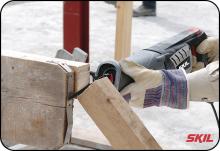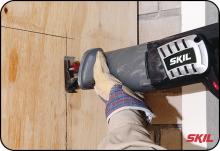-
How to get an optimal sawing performance
To get the best possible results with a reciprocating saw, you should give due consideration to the following aspects when working:
- Place the nicer side of the workpiece facing down to minimise splintering
- Mark out a sawing line on your workpiece
- Cover the sawing line with a few layers of wide sticky tape to prevent splintering
- Select the desired sawing speed (you can test out the options on a piece of waste material)
- Make sure the saw is operating at its top speed before guiding the tool into the workpiece
- Press the footplate firmly against the workpiece to minimize kickback and vibrations
- Let the saw do the work. Applying too much forward pressure will reduce the speed of the blade, which will slow your work down
-
When you start sawing in the middle of a workpiece, also called plunge cutting – to create a recess in furniture, say – you need to factor in other considerations, as follows:
- Use a thick blade and attach it with the teeth facing upward
- Tilt the saw so that the blade doesn’t touch the workpiece
- Allow the moving blade to carefully engage with the workpiece
- Saw along the line you’ve marked on the workpiece until the saw goes all the way through

